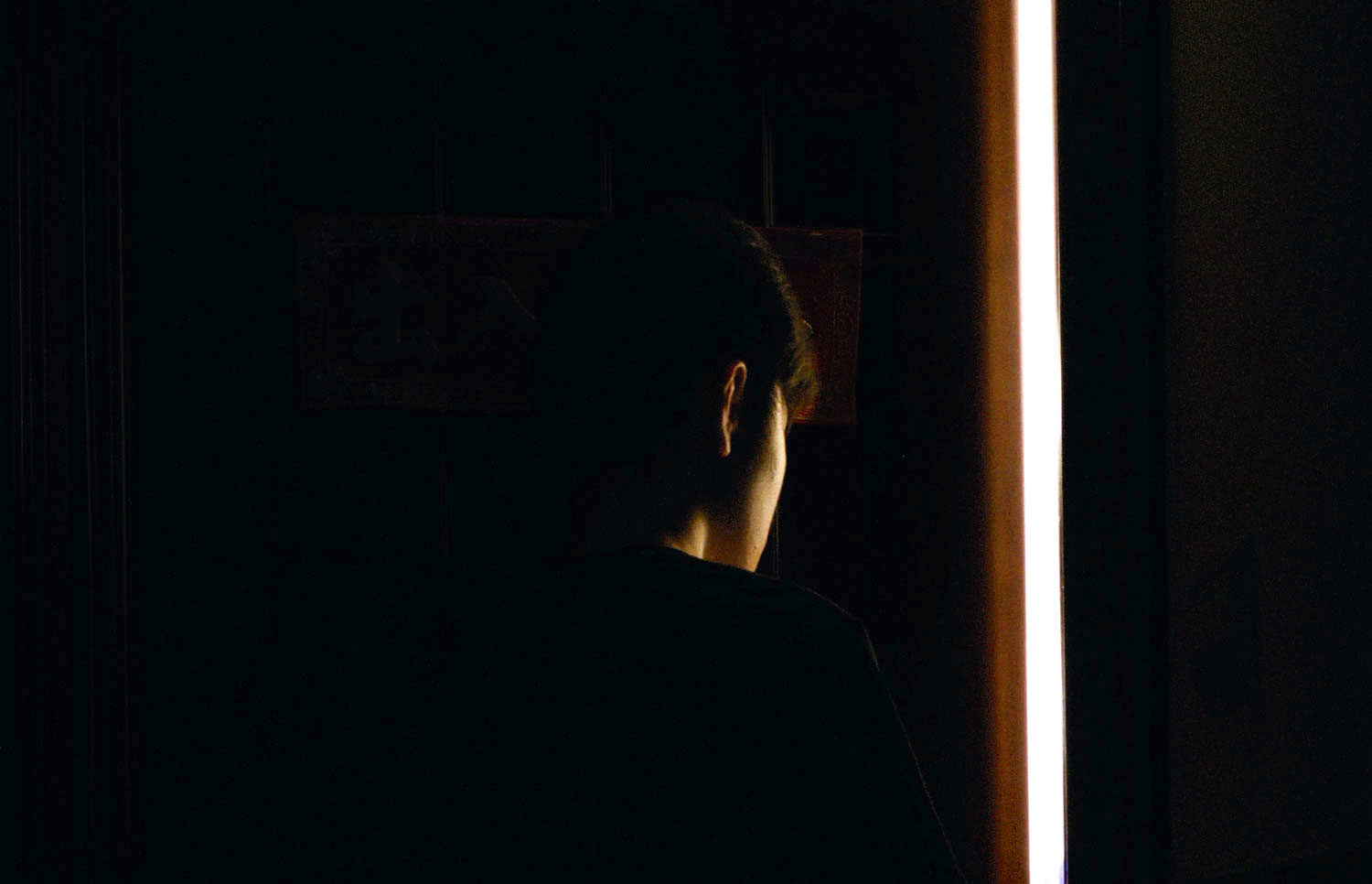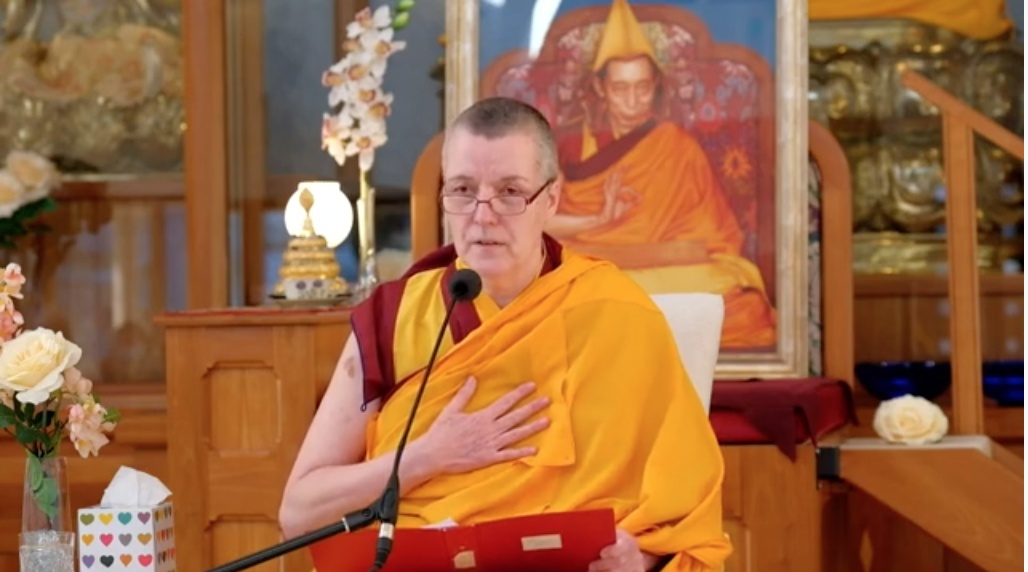Scorpion Pose Guide: Build Confidence for this Challenging Inversion with Detailed, Step-by-Step Instructions
The post Scorpion Pose Guide: Build Confidence for this Challenging Inversion with Detailed, Step-by-Step Instructions appeared first on The Yoga Nomads.

In addition to the many well-known physical benefits yoga, taking up an asana practice can transform your whole life in truly amazing ways. Practicing yoga helps build resilience, confidence, mental focus, and presence. Taking on new challenges within your asana practice can be a truly transformative experience, helping you explore new dimensions of your whole self — physically, mentally, emotionally, and spiritually.
In this article, we’ll explore one yoga posture that perfectly embodies this experience of positive transformation: Scorpion Pose! This advanced posture combines several different elements, being classified as an arm balance, inversion, and back-bending pose.
Name and Symbolism
In Sanskrit, the name Vrschikasana is a literal translation. Vrschika means “scorpion” while asana means pose. However, you’ll likely hear your yoga teacher use the common English name for this posture. Visually, it is easy to see how the pose got its name: with the torso arched and feet curling forward over the head, the body clearly resembles the shape of a scorpion’s tail.

The meaning of the name runs even deeper, however, when considering the symbolism of scorpions. In many cultures, these fascinating creatures represent renewal, rebirth, and positive transformation. The goal in Scorpion Pose is to eventually rest the soles of the feet on the top of the head in a deep backbend position. Symbolically, you can imagine your feet “stamping” out the negative qualities that live inside your head: pride, jealousy, anger, and all-things ego. Simultaneously, your chest and heart are open, cultivating feelings of tolerance, harmony, and loving-kindness.

This goes to show that when practiced with intention, visually impressive yoga poses like Scorpion can offer benefits far beyond just the physical level… So, are you ready to transform your yoga practice — and yourself — with a challenging new pose? Here, we’ve provided you with all you need to know about this awe-inspiring asana!
Scorpion Pose Benefits
Physically, there is a lot going on in Vrschikasana, which naturally means there are numerous physical benefits! As an arm balance, inversion, and backbend, Scorpion Pose:
strengthens the arms, back, and shoulder muscles stretches the hip flexors, abdominal region, quadriceps, and chest muscles builds core strength improves spinal flexibility reverses negative effects of slouched posture increases lung capacity by opening the chestOf course, tackling an advanced asana produces many positive mental and energetic effects. Working on a challenging pose like Scorpion also:
builds confidence improves balance, body awareness, and proprioception boosts energy levels increases focus and mental fortitudeHow To Practice Scorpion Pose
Advanced poses like Scorpion require a solid foundation in your yoga practice. Before attempting this challenging posture, you’ll first need to be familiar and comfortable with basic yoga poses like Downward Facing Dog and Forearm Plank; these poses will set you up for Dolphin Pose, the main entry point for Scorpion. In the following step-by-step instructions for Scorpion, we’ve given a brief description of Dolphin Pose; however, if you need more tips for proper alignment, be sure to review our article breaking down Dolphin Pose.
So, now that you’re ready to take your practice to the next level — roll out your yoga mat and give Scorpion Pose a try! Here’s how:
Begin in Dolphin Pose: from Downward Facing Dog, lower your elbows and forearms to the floor at a shoulder width apart. Ground your wrists and palms into the floor while you press the floor away to lift up and out of your shoulder joint. Move into a high and tight Dolphin: come high up on the balls of the feet and gradually walk your feet as close to your elbows as possible. Think about stacking your hips over your shoulders. Shift your gaze forward slightly, between your hands. Pull your low belly in and up to engage your core. Lift one leg up, bringing it into a straight line with your hips and shoulders. This is known as Half Feathered Peacock Pose (Ardha Pincha Mayurasana). Then, bend your other knee slightly and push off the ball of the foot. Keep this lower knee bent and tuck your foot in towards your glutes, then place it back down to the floor. You might try a couple of these small hops to find your center of gravity. When you feel ready, hold your balance and extend both legs up into Forearm Stand (Pincha Mayurasana, or Feathered Peacock Pose). Once you feel solid in your Forearm Stand, slowly start to bend your knees; see how far you can bend your knees naturally, bringing your feet towards your head. As your upper body comes into a backbend, your hips will naturally shift back a bit, but will be counter-balanced by your feet coming forward. When you can’t bend your knees any further, you can move into a deep backbend by bringing your chest forward as you keep reaching your big toes toward the top of your head. Keep gazing just beyond your hands so that you maintain length in the back of your neck.Pro tip: The more you can open across the front of your chest, the closer you’ll be able to bring your towards your head to create the shape of a scorpion’s curled tail. Hold the final position of Scorpion Pose for a few slow breaths. When you are ready to exit Scorpion, first return to Forearm Stand: extend your legs with control, bringing your feet towards the sky. Then, release one leg to the ground in a split-leg Dolphin pose. Bring the other leg down, release your knees to the floor, and take a rest in Child’s Pose.
For a visual demonstration, watch this excellent tutorial:
Alignment Pro-Tips and Yoga Teacher Cues
Here are a few tips for refining your alignment in Scorpion Pose that will help you practice this asana safely and successfully. If you’re a yoga teacher, you might share these tips with your students to help deepen their experience and understanding of the pose.
Maintain length in the back of the neck as you bring your chest forward; avoid straining or crunching your neck by keeping your gaze slightly in front of your hands. Ground down evenly through all ten fingertips and the palm of each hand. You should not put too much weight on the heels of your hands, as this can lead to discomfort in your wrists. Use your core strength to support your backbend — you should maintain an even curve throughout your spine, rather than having a sharp angle in your lower back. To maintain a more stable foundation, keep your elbows aligned under your shoulders and ground down evenly through your forearms to avoid collapsing onto the outer edges of your wrists. Remember to breathe! There is a tendency to hold the breath in balancing postures; however, maintaining a steady breath actually improves balance and focus!Contraindications
As an advanced yoga pose that combines many elements such as balance, inversion, and backbend, there are several instances in which you should avoid Scorpion Pose, including:
injury to the back, spine, or shoulders hip injuries pregnancy high blood pressure vertigo or dizzinessModifications for Scorpion Pose
Inversions and arm balances can be intimidating upon first glance, especially for a new yoga practitioner. It is always wise to practice this pose with the guidance of a yoga teacher when first starting out. Should you wish to practice your Scorpion Pose on your own, however, here are some ways to support yourself with props.
 Wall: set up your mat in front of a wall, and come into Dolphin (index fingers pointing toward the wall) about 1-2 feet away. Follow the instructions to kick up into Forearm Stand. Then, as you bend your knees you can rest the tops of your feet against the wall for extra support. Using this method, you can work on bringing your heart forward and opening more across your chest.
Bolsters: again, set up in front of a wall as described above. Next, stack 3-4 yoga bolsters positioned against the wall. When you bend your knees to come into Scorpion from Forearm Stand, you can gently rest your feet on your stack of cushions to feel more balanced and supported.
Wall: set up your mat in front of a wall, and come into Dolphin (index fingers pointing toward the wall) about 1-2 feet away. Follow the instructions to kick up into Forearm Stand. Then, as you bend your knees you can rest the tops of your feet against the wall for extra support. Using this method, you can work on bringing your heart forward and opening more across your chest.
Bolsters: again, set up in front of a wall as described above. Next, stack 3-4 yoga bolsters positioned against the wall. When you bend your knees to come into Scorpion from Forearm Stand, you can gently rest your feet on your stack of cushions to feel more balanced and supported.
 Chair: once you are ready to move away from the wall, place a chair 1-2 feet in front of you, with the seat of the chair facing towards you. You can use seat of the chair in the same way as you would a stack of bolsters, providing support for your feet as you bend your knees and come into Scorpion.
Chair: once you are ready to move away from the wall, place a chair 1-2 feet in front of you, with the seat of the chair facing towards you. You can use seat of the chair in the same way as you would a stack of bolsters, providing support for your feet as you bend your knees and come into Scorpion.
Preparatory Poses
Typically, you’ll practice Scorpion as a peak pose in your yoga practice. It’s important to be sure your body is adequately warmed before attempting this challenging inversion with an added backbend. Each of these poses below will bring attention to specific muscles in your body that are essential for Scorpion Pose.
Forearm Plank

Regularly practicing Forearm Plank will strengthen your shoulders and upper arms, giving you a solid foundation for Scorpion. This yoga pose also is one of the best for building core strength, which improves balance in any inversion.
To practice this plan variation, begin in a Table Top position, on all fours. Lower down to your elbows, resting your forearms on the floor parallel to the long end of your yoga mat. Step your feet back one at a time, extending your legs straight behind you. Pull your navel in and up so your core is active. Stack your hells over the balls of your feet and gently pull your kneecaps up to engage all the muscles of your legs. Try to hold this position for at least 30 seconds, then release your knees back down to the floor and rest in Child’s Pose.
Dolphin Pose
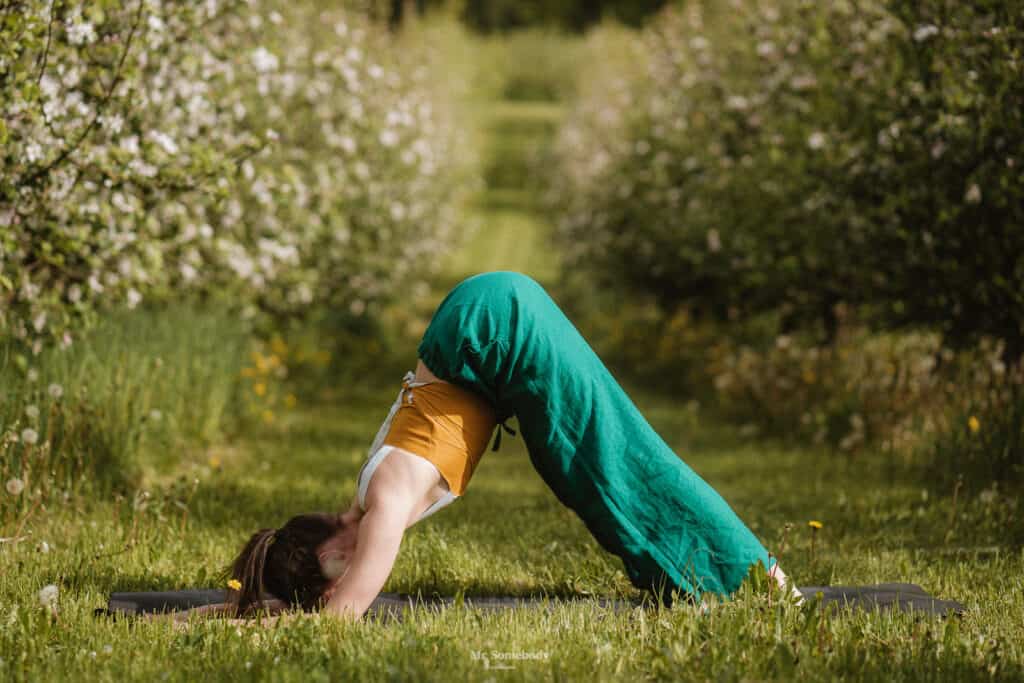
Activate the muscles of your arms, shoulders, and back with Dolphin. This posture will help build upper body strength, and is the foundation for entering Scorpion Pose, so be sure to include this one in your warm-up!
Pigeon Pose
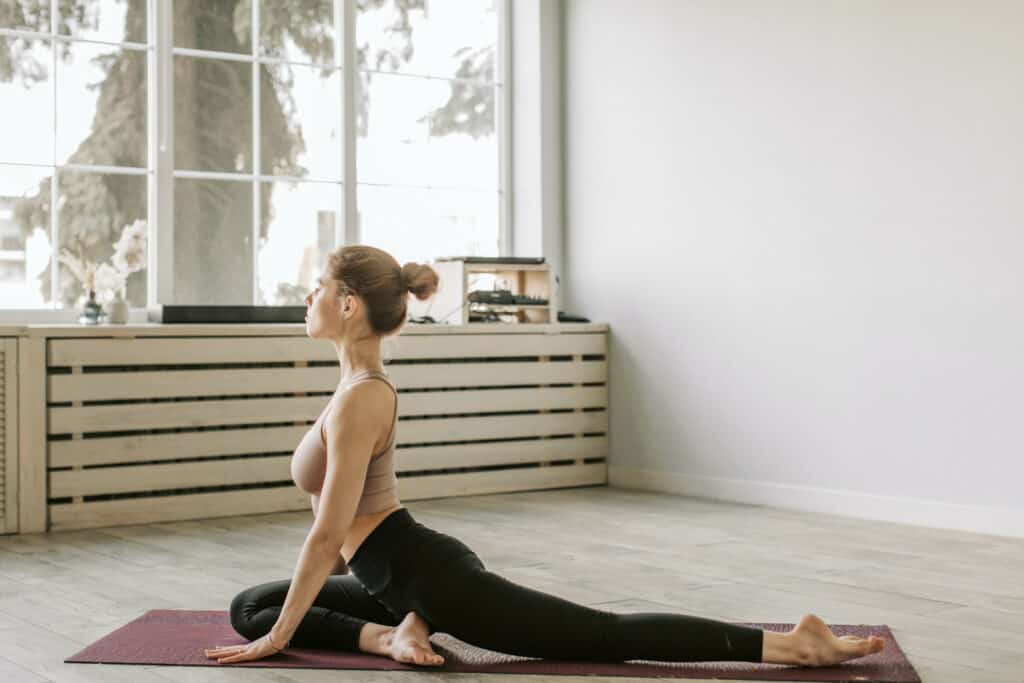
Scorpion Pose stretches the entire front side of your body, especially the hip flexors. Pigeon Pose will open your hips to help you create the beautiful, curved Scorpion tail shape in Vrschikasana. To review proper alignment of Pigeon Pose, you can check out or in-depth pose guide here!
Wheel Pose
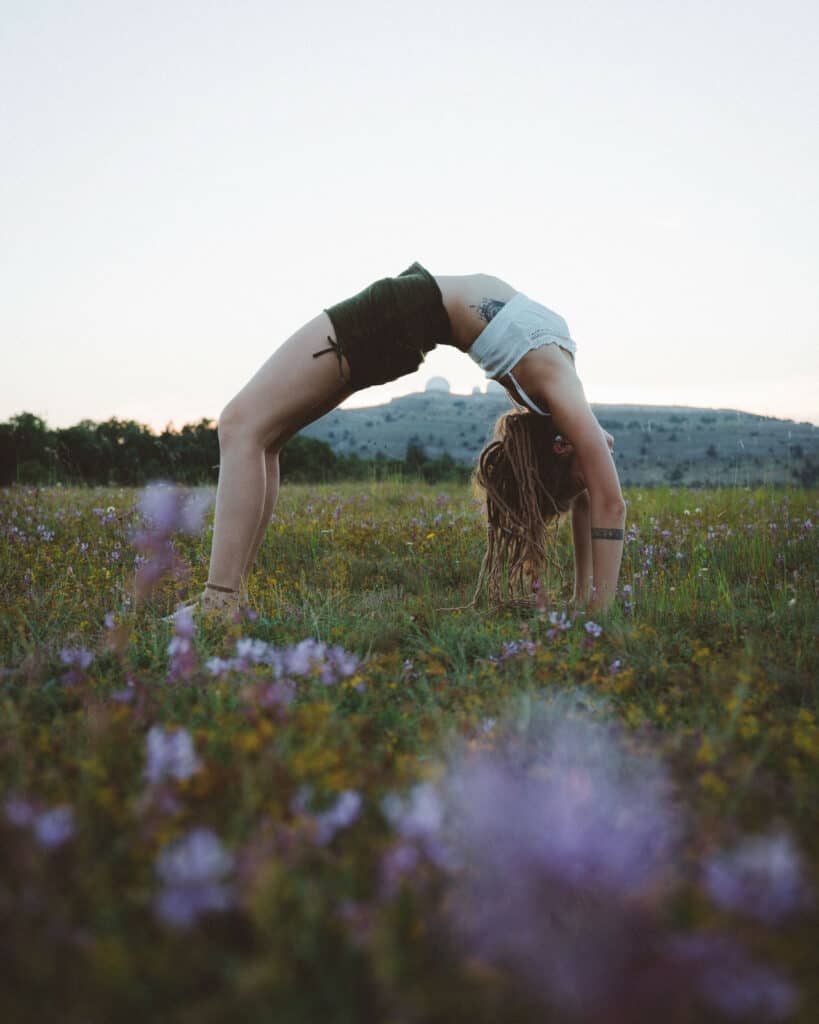
One of the best ways to improve your Scorpion Pose is by working on other backbends like Wheel Pose, which stretches your front body, especially the chest. You’ll also strengthen and mobilize your spine, making it easier to achieve the final step in Scorpion of bringing your toes to your head.
To practice Wheel Pose, begin lying on your back with your knees bent and feet planted at a hip width distance. Bend your arms and plant your hands just about your shoulders, with your fingers pointing in the same direction as your toes, elbows toward the sky. With an inhale, lift your hips into Bridge Pose. On your next breath, push into the ground to lift your shoulders, neck, and head off the floor while you straighten your arms.
Create space in your chest by drawing your shoulder blades together. Keep your legs active, squeezing your inner thighs toward your midline. Feel an even curve all throughout the length of your spine. Hold your Wheel Pose for 5-10 breaths, then carefully lower yourself back down to your mat and rest in Savasana.
Forearm Stand

As another building block of Scoprion Pose, of course it is essential to practice Forearm Stand — also known as Feathered Peacock Pose. With regular practice, this balancing inversion stretches and strengthens your spine, shoulders, and upper arms. Once you have a solid Forearm Stand in your yoga practice, you’ll be ready for many fun and advanced variations of other inversions! Simply follow the detailed instructions above, and pause at Step 4.
Follow-up Poses and Advanced Variations
Follow-up poses may help you take your Scorpion Pose to the next level of more advanced backbends or other inversions. On the other hand, you might choose a counter pose to let your body relax and rest after the physically demanding Vrschikasana, which requires full body engagement.
Variations to Level-Up Your Scorpion Pose
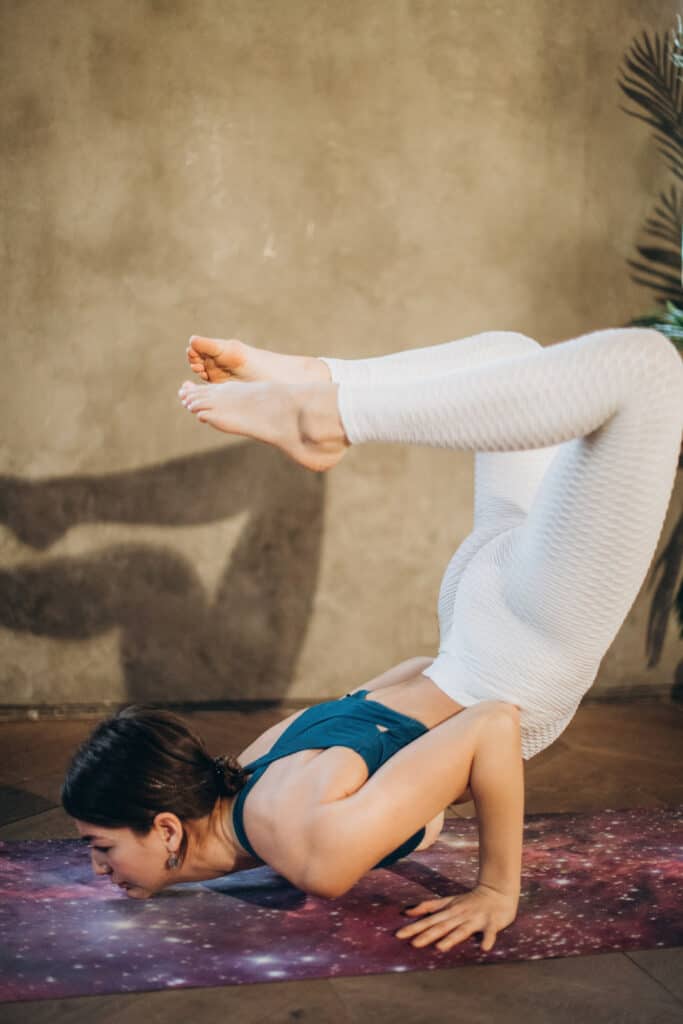
If you’re feeling confident, strong, and flexible enough to hold the classic Scorpion Pose on your forearms, you can combine the shape with other advanced inversions. Try adding the Scorpion backbend to create challenging variations of classic balancing poses like Handstand and Chin Stand (Formidable Face Pose). For instructions on how to achieve these impressive postures, read through our article detailing 11 Inspiring Advanced Poses for Hardcore Yogis!
Child’s Pose

Balasana (Child’s Pose) always feels fantastic after any back-bending yoga pose, as it stretches the muscles of your back that contract during a backbend. This resting pose will give you a chance to relax your arms and shoulders as well. To learn more about Balasana, visit our Child’s Pose guide!
Savasana

After an intense and challenging peak pose like Scorpion, you certainly deserve a rest in Savasana (Corpse Pose). Lying flat on your back helps return your spine to a neutral position, and allows your body to integrate all the benefits of an inverted posture. To learn more about all the amazing affects of Savasana, check out our complete Corpse Pose guide!
Common Questions About Scorpion Pose
In Scorpion Pose, do you balance on the forearms or the hands?
Usually, Scorpion Pose is done is a forearm balance; however, there is a handstand variation as well! When you are new to inversions, starting with a forearm balance will help you build strength and confidence, being a bit closer to the ground and using a wider foundation. If you feel comfortable and stable in a handstand, adding the Scorpion Pose shape will be a fun challenge!
I’m only a beginner, but would like to work up towards Scorpion Pose. What should I focus on?
In order to achieve Scorpion Pose, you’ll need a good deal of strength not just in your upper body, but your back body as well. You’ll also benefit from working on backbends to increase your range of motion. Besides working on the preparatory poses suggested above, try to regularly practice yoga poses like Cobra, Bridge, Locust, Bow, Camel and Wheel Pose.
How can I be sure to avoid injury when I’m trying this advanced yoga pose for the first time?
As with any yoga asana of any level, the short answer is: listen to your body! Especially with back-bending postures, you must not push yourself beyond your physical limits. Honor the natural, gradual progression of your yoga practice and proceed with patience and curiosity. And of course, be sure you are properly warmed up with the preparatory poses mentioned above!

 Tfoso
Tfoso 







